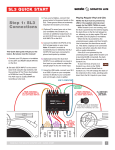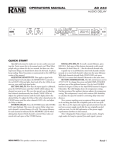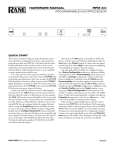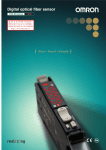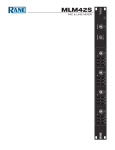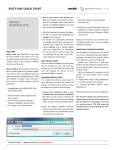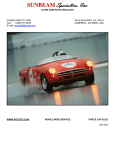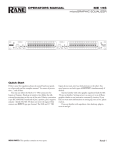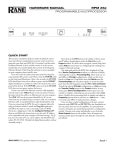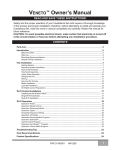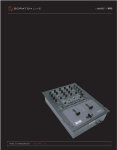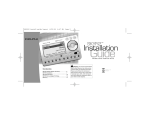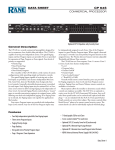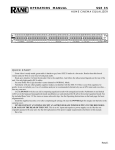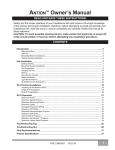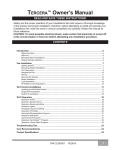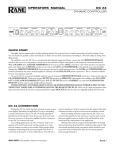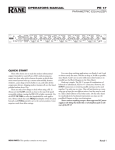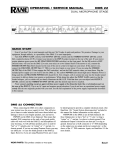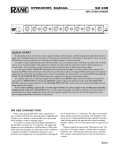Download Rane DC225 User's Manual
Transcript
OPERATORS MANUAL DC 22S STEREO COMPRESSOR INPUT 1 GATE -60 -70 +4 OL LEVEL -80 -50 COMPRESSOR -40 -30 -20 dBu THRESHOLD -20 -30 -40 -10 0 1.7 2 10 1.2 20 dBu THRESHOLD OUTPUT INPUT 0 2 3 6 3 10 12 24 -6 -12 12 -15 1 :1 RATIO GAIN REDUCTION BYPASS 6 LINK dB LEVEL -70 +4 15 � MASTER SLAVE � GATE -60 OL LEVEL -80 -50 COMPRESSOR -40 -30 -20 dBu THRESHOLD -20 -30 -40 -10 0 1.7 2 10 1.2 20 dBu THRESHOLD OUTPUT 3 6 3 10 12 24 -6 0 -12 :1 RATIO GAIN REDUCTION BYPASS DC 22S 6 DYNAMIC CONTROLLER 12 -15 1 15 dB LEVEL POWER QUICK START Shredded, this document makes excellent packing material. In its present form, it makes interesting and useful reading. If you run out of patience quickly, at least read this part to make sure you don’t exterminate everything within a two mile radius by doing something wrong. First, be sure the POWER switch is off. Attach one or two channels of Inputs and Outputs to the respective connectors on the rear. This device uses low impedance balanced line drivers. Do not connect the XLR “+” or “–” output pins to ground, as this may cause the power supply to shut down. For unbalanced use, leave the unused output pin (“+” or “–”) unterminated. OK, now you can power up your sound system, volumes down, amp turned on last. With the GATE THRESHOLD turned all the way down to -80 dBu, COMPRESSOR THRESHOLD turned all the way up to 20 dBu, COMPRESSOR RATIO turned all the way down to 1, and the OUTPUT LEVEL control in the center at 0 dB, you have an expensive patch cord. While sending a signal to the DC 22S, adjust the output level of the previous device so the +4 dBu LED lights occasionally, but the OL LED does not light. If you are driving the ¼" WEAR PARTS: This product contains no wear parts. INPUTS with a balanced signal (tip-ring-sleeve), set the Input Gain switch to +4 dBu (in). When driving this input with an unbalanced signal (tip-sleeve), set this switch to –10 dBv (out). Regardless of the type of Input, you might need to set this switch so the INPUT LEVEL LEDs light correctly. Now increase the COMPRESSOR RATIO to something useful, like 2:1 (with the control set at 2, the Ratio is 2:1; at 5, it is 5:1.) Adjust the COMPRESSOR THRESHOLD to the point you want the Compressor to kick in. The GAIN REDUCTION meter reads the amount of signal compression. If you want the quiet parts to be even quieter, increase the GATE THRESHOLD so only higher levels make it through the Gate. Both Gates and Compressors will activate by the source material applied to either channel if the LINK switch is on. This is the preferred setting for stereo program material. The channel 1 controls set both channels to the same adjustments, as the channel 2 controls go dormant and the LEDs extinguish. If the LINK switch is off, then both channels are independently controllable. Manual-1 Front Panel Description INPUT INPUT LEVEL indicators: With signal applied, the +4 dBu LED may light occasionally. If the OL (overload) LED flashes, turn the output level down on the previous device. 1 2 LEVEL -30 -30 10 1.2 10 0 -30 1.7 -40 -30 -20 dBu THRESHOLD 2 20 dBu THRESHOLD 0 -6 6 -12 24 12 -15 20 dBu THRESHOLD OUT 3 6 3 10 LINK 2 SLAVE � -60 -70 +4 � MASTER GATE OL LEVEL -80 -50 COMPRESSOR 12 -12 24 -15 1 :1 RATIO GAIN REDUCTION BYPASS -40 -30 -20 dBu THRESHOLD -20 -30 -40 -10 0 1.7 2 10 1.2 20 dBu THRESHOLD 6 3 10 -6 12 0 -12 24 2 LINK +4 � MASTER SLAVE � :1 RATIO GAIN REDUCTION BYPASS DC 22S 6 DYNAMIC CONTROLLER 12 -15 1 15 dB LEVEL POWER When the POWER LED is lit, the DC 22S is connected to a 100-240 VAC source and ready to rock. Manual-2 d LEV INP OUTPUT 3 0 -6 Channel 2 controls duplicate the controls in channel 1. These are not active if the LINK switch is engaged. INPUT 1 -40 15 dB LEVEL BYPASS 0 -30 OUTPUT LINK when 1 either channel’s -80 switch -20activates both -40 Compressors 20 signal exceeds the set Threshold, preserving stereo :1 imaging.GAIN dBu dBu THRESHOLD THRESHOLD RATIO Switch this ON when using stereo material. The channelREDUCTION 1 controls become the Master when this switch is active, rendering the channel 2 controls and indicators dead. _____________________________________________ -10 -20 -80 10 1.2 -40 dBu THRESHOLD OUTPUT LEVEL control increases or decreases the output3 2 -50 -10 gain of each Channel by 15 dB. In0the center detent, 3gain 6will 1.7 -60 -40 -20 be unity. 12 -70 -10 -20 BYPASS switch compares the compressed and non-compressed signal. There is one for each channel. The INPUT LEVEL indicators remain active regardless of switch position. INPUT GATE COMPRESSOR OL CO COMPRESSOR GAIN REDUCTION LEDs show the amount of average signal reduction in dB. This aids in setting the THRESHOLD and RATIO controls by showing how much compression is occuring. _____________________________________________ +4 OL LEVEL COMPRESSOR THRESHOLD control sets the point at which the Input signal level causes the Compressor to become active. See Figure 1 on page Manual-4. INPUT GATE COMPRESSOR RATIO control: Once the Threshold is exceeded, the Ratio of input change to output change is deter--50 -60set -40 mined by this control. The compressor has no1 effect when at 1:1. But at 10:1, it takes a 10 dB input signal increase above -70 -30 the Threshold to produce a 1 dB increase in+4 Output OL Gain. See -80 -20 Figure 2 on page Manual-4. 1 -50 -60 -70 +4 GATE THRESHOLD control sets the point at which the Input signal level causes the Gate to become active. _____________________________________________ LEVEL GATE LEV Rear Panel Description DC 22S WIRING 3-PIN XLR: DE IN U.S.A. ANE CORP. • PIN 2 = (+), • PIN 3 = (–), • PIN 1 = CHASSIS (SHIELD) OUTPUT INPUT 2 2 1/4" PHONE, BALANCED: -10 dBV +4 dBu • TIP = (+), • RING = (–), • SLEEVE = CHASSIS (SHIELD) N 001 345 482 This device co 15 of the FCC is subject to t conditions: (1) not cause harm and (2) this de any interfer including inter cause undesire 1/4" PHONE, UNBALANCED: • SEE THE RANENOTE: SOUND SYSTEM INTERCONNECTION BALANCED BAL/UNBAL BALANCED BAL/UNBAL INPUTS 1 and 2: Choose between the balanced XLR or the balanced/unbalanced ¼" TRS jacks, but only use one. Inserting a ¼" TS jack will work—however—we recommend using balanced lines, especially when connecting any cable over 10 feet (3 meters) in length. Consult the Sound System Interconnection RaneNote provided with this manual. INPUTS 1 and 2 Gain Trim Switch: In its +4 dBu position, the Input gain of the respective channel is unity. In the -10 dBV position, the input gain is increased by 12 dB (although mathematically suspicious, it really is 12 dB, not 14 dB) to compensate for certain recording devices. This switch must be in the +4 dBu position for front panel calibration accuracy. OUTPUTS 1 and 2 are delivered by the balanced XLR or the unbalanced ¼" TS jacks. Using both types of Outputs are permissible to drive two devices, such as an amplifier and a recorder. This device uses low impedance balanced line drivers. Do not connect the XLR “+” or “–” output pins to ground, as this may cause the power supply to shut down. For unbalanced use, leave the unused output pin (“+” or “–”) unterminated. OUTPUTS LEFT RIGHT INPUTS LEFT RIGHT 0 10 LEVEL 0 10 LEVEL RIGHT SPEAKER STEREO AMP, HIGH AC 22S COMMERCIAL AUDIO 100-240 V EQUIPMENT 24TJ 50/60 Hz 7 WATTS HIGH OUT LOW OUT CH 2 IN STEREO 2-WAY MADE IN U.S.A. RANE CORP. SUBWOOFER SWITCH MUST BE SET TO 2- CHANNEL FOR MONO 3-WAY R MODE ACN 001 345 482 HIGH OUT MONO SUB: OMIT MID OUT MONO 3-WAY OMIT MONO HIGH OUT LOW OUT CH 1 IN OMIT MONO MONO SUB OUT LOW OUT PIN 2: POSITIVE PIN 3: NEGATIVE PIN 1: CHASSIS GND SUBWOOFER 2-CHANNEL MONO SUB MONO 3-WAY IN This device complies with Part 15 of the FCC Rules. Operation is subject to the following two conditions: (1) this device may not cause harmful interference, and (2) this device must accept any interference received, including interference that may cause undesired operation. AC 22S STEREO 2-WAY CROSSOVER 100-240 V 50/60 Hz 7 WATTS ME 15S COMMERCIAL AUDIO EQUIPMENT 24TJ CHANNEL 2 MADE IN U.S.A. RANE CORP. OUTPUT WIRING INPUT ACN 001 345 482 LEFT SPEAKER CHANNEL 1 This device complies with Part 15 of the FCC Rules. Operation is subject to the following two conditions: (1) this device may not cause harmful interference, and (2) this device must accept any interference received, including interference that may cause undesired operation. TIP / PIN 2 = POSITIVE RING / PIN 3 = NEGATIVE SLEEVE = SIGNAL GROUND PIN 1 = CHASSIS GROUND R OUTPUT INPUT ME 15S STEREO EQUALIZER DC 22S COMMERCIAL AUDIO EQUIPMENT 24TJ MADE IN U.S.A. RANE CORP. WIRING 3-PIN XLR: OUTPUT INPUT 2 2 • PIN 2 = (+), • PIN 3 = (–), • PIN 1 = CHASSIS (SHIELD) 1/4" PHONE, BALANCED: R ACN 001 345 482 100-240 V 50/60 Hz 7 WATTS -10 dBV +4 dBu • TIP = (+), • RING = (–), • SLEEVE = CHASSIS (SHIELD) 1/4" PHONE, UNBALANCED: • SEE THE RANENOTE: SOUND SYSTEM INTERCONNECTION BALANCED BAL/UNBAL BALANCED OUTPUT INPUT 1 1 This device complies with Part 15 of the FCC Rules. Operation is subject to the following two conditions: (1) this device may not cause harmful interference, and (2) this device must accept any interference received, including interference that may cause undesired operation. -10 dBV +4 dBu BAL/UNBAL BALANCED BAL/UNBAL BALANCED BAL/UNBAL DC 22S STEREO COMPRESSOR MONO SUBWOOFER TTM 56S COMMERCIAL AUDIO EQUIPMENT 24TJ MADE IN U.S.A. RANE CORP. U.S. PATENT 6,813,361 R POWER TTM 56S MIXER ACN 001 345 482 MASTER OUTPUTS L AUX OUT FlexFX L IN PHONO GROUNDS PGM 2 4 L 1 L R R BALANCED 2 L SEND RETURN R 100-240V 50/60 Hz 20 WATTS MIC OUT R IN UNBALANCED 4 R 3 BALANCED PGM 1 3 L PHONO 4321 EFFECTS 4321 LINE TIP = SEND RING = RTN R 2 OUTPUTS 1 LEFT RIGHT INPUTS LEFT RIGHT 0 10 LEVEL 0 10 LEVEL MONO OR BRIDGED AMP, MONO SUB System wiring example for a DJ system Manual-3 OPERATING INSTRUCTIONS A PRIMER Let’s start with what a compressor actually does. No matter how you cut it, this is an automatic volume control. It is a hand on a knob, turning the volume down and turning it up again. The hand is really quick and really accurate, but it’s just turning a volume control. When the input signal reaches a level set by the COMPRESSOR THRESHOLD control, the compressor begins turning down the signal by an amount determined by the RATIO control. The DC 22S, like most compressors, operates by making the loud signals quieter, but does not make the quiet parts louder. However, by keeping the loud signals under control, the entire system may be turned up when necessary to make the quiet parts louder. PRE-FLIGHT CHECKLIST Before proceeding, it’s a good idea to turn the control knobs to the following positions: 1. GATE THRESHOLD control......fully counterclockwise 2. COMPRESSOR THRESHOLD....fully clockwise 3. COMPRESSOR RATIO...............fully counterclockwise 4. BYPASS switches......................ACTIVE (out) 5. OUTPUT LEVEL.........................0 dB This renders the DC 22S with no compression, allowing signal through at unity gain. No change occurs with the BYPASS switch in or out. INPUT LEVEL Before making any Threshold adjustments, set the ouput level of the previous device so the +4 dBu LED lights occasionally, and the OL LED does not light. Be aware that changes to the Input Level will affect the Thresholds. GATE THRESHOLD The threshold is the point at which gain adjustment begins. When the input signal is below the threshold, the DC 22S attenuates the signal at a 2:1 ratio, making the quiet parts twice as quiet. When the signal is above the Gate Threshold, the Gate is open, like a straight wire. AUDIO PRECISION amp 0 AMPL(dBr) vs AMPL(dBu) 09 AUG 101 14:51:28 -10 RATIO AUDIO PRECISION 20 AMPL(dBr) VS AMPL(dBu) 09 AUG 101 14:34:57 10 10 O 0 U T -10 P U -20 T 0 -10 -20 -30 -30 d B -40 u -40 -50 -60 -60 -50 -40 -30 -20 -10 INPUT (dBu) 0 10 20 Figure 2. With the Ratio set to ∞, the DC 22S acts as a Limiter. This graph shows Limiter gain reduction above various Compressor Thresholds at 10 dBu, 0 dBu, -10 dBu, etc. Once the Threshold is exceeded, the increase in output compared to the input signal increase depends on the RATIO setting. An ordinary preamp set for unity gain or a straight wire has a ratio of 1:1, that is, the output level tracks the input level perfectly. A 2 dB change at the input produces a 2 dB change at the output. For a 10:1 Ratio, a 10 dB blast at the input would rise only 1 dB at the output – heavy compression. Kinder, gentler ratios are in the 2:1 to 3:1 range. Limiting, with no increase in signal above the Threshold, occurs at ∞:1. Figure 3 illustrates various Ratios. AMPL(dBr) vs AMPL(dBu) AUDIO PRECISION 20 09 AUG 101 14:45:47 -60 d -30 B u -40 -70 -50 -50 -80 -80 -70 -60 -50 -40 -30 INPUT (dBu) -20 -10 0 Figure 1. With a fixed Ratio set to 2:1, this graph shows gain reduction below various Gate Thresholds at -20 dBu, -30 dBu, -40 dBu, etc. Manual-4 -60 1:1 1.2:1 10 O U 0 T P -10 U T -20 O -20 U T -30 P U -40 T d B u COMPRESSOR THRESHOLD The threshold is the point at which gain adjustment begins. When the input signal is below the threshold, the Compressor section acts like a straight wire. When the signal is loud enough to cross the Compressor Threshold, the compressor is active and turns the volume down. Various Threshold points are illustrated in Figure 1. How much it gets turned down is determined by the RATIO control ( Figure 1 shows a Ratio set at 2:1). 1.5:1 2:1 3:1 6:1 ∞:1 -60 -50 -40 -30 -20 -10 INPUT (dBu) 0 10 20 FIgure 3. Threshold at -40 dBu. Ratios of 1:1, 1.2:1, 1.5:1, etc. Vertical axis = output level, horizontal axis = input level. LIMITING A limiter is a special form of compressor set up especially to reduce peaks for overload protection. In other words, it’s a compressor with a maximum ratio. A compressor is used to change the dynamics for purposes of aesthetics, intelligibility, recording or broadcast limitations. Once the threshold of a limiter is reached, no more signal increase is allowed. The DC 22S acts as a limiter when set at a very high ratio of 10:1. LINKING IN STEREO When using the DC 22S as a true stereo processor, with left signal in Channel 1 and right signal in Channel 2, it is recommended to turn the LINK switch on to prevent large balance and image shifts. While LINKed, both Channels attenuate by exactly the same amount when either Compressor works, maintaining correct stereo imaging. Only Channel 1's controls are active, Channel 2 becomes the slave. DC 22S APPLICATIONS TWO CHANNEL COMPRESSOR/LIMITER In this case, the audio path on Channel 1 is completely separate from Channel 2, allowing you to use it as a stereo unit or for doing two completely different processes to two completely different signals. For stereo use, the front panel LINK switch allows you to link Channels. When either Channel’s Threshold is reached, both channels compress equally, preserving the stereo image. Channel 1’s Threshold and Ratio settings will affect both Channels. GUITAR & BASS Where does the unit go in the signal chain? Well, that depends on how you want it to function. If it’s a comp/limiter for the input signal, it would go after the guitar (if the guitar has a line-level output) and before the preamp. If it’s to function as a limiter to protect the speakers in the rig, it would go after the preamp and before the power amp. Another method is to insert the unit in the effect loop of the preamp. This allows the bass signal to be affected by the pre-amp first, then the comp/limiter, and then sent to the power amp. This can be desirable with tube pre-amps. RECORDING Use it on bass guitar, piano, drums, or vocals—as an effect or to tailor dynamic range for a particular recording medium. Patch it between line-level devices or in your mixer inserts or “loops”. The DC 22S gives you more control and a less tortured sound, and keeps instruments sounding “up-front.” In digital recording, compress an extremely wide dynamic range into a signal that won’t go into digital overload, i.e. severe clipping. This is really valuable during a live digital recording when you just don’t know how loud it may get, and digital distortion can ruin an otherwise good take. Set both the COMPRESSOR THRESHOLD and RATIO relatively high, just enough to limit the peaks. Set the GATE THRESHOLD very low, though you might want to raise it just above the noise floor to get rid of tape hiss or processor noise. Of special interest are instruments which have large level differences in their tonal ranges. String pops on a bass are one example, shrill peaks on a flute are yet another. The higher tones require more breath and can seem much louder than lower pitches. Another good application would be a drum mix or vocal submix. LONG DISTANCE LINE DRIVER The DC 22S is excellent as a line level amp for driving long lines (from the mixer to the stage for instance). With the COMPRESSOR switch in the BYPASS position, the INPUT LEVEL control and the output amplifiers remain in the circuit. This provides a very low distortion, low noise line driver. Balanced XLR connections are recommended for the long run from the DC 22S's outputs (anything over 10 feet [3 meters]). A balanced piece of equipment (equalizer or amplifier) must be used at the receiving end of this long line. For unbalanced systems, use the ¼" inputs on the DC 22S and use the balanced XLR outputs to run the long distance. See the RaneNote “Sound System Interconnection” included with this manual for proper cable wiring. SOUND SYSTEM WITH COMPRESSION Let’s run a stereo system with compression. See the wiring diagram on page Manual-3. Patch the DC 22S Compressor Inputs from the program source or mixer outputs, and send the DC 22S Outputs to the system equalizer (if you have one), and then on to the crossover inputs (if you have one). Set the equalizer and crossover Inputs to unity gain. Set the LINK switch to ON, and adjust the CHANNEL 1 COMPRESSOR THRESHOLD and RATIO controls to keep the entire system dynamic range under control. Locating the compressor before the equalizer results in correct spectral balance during compression. DRIVER PROTECTION To individually limit Low and High drivers in a biamped system, connect the Crossover Low Output into one DC 22S Input, and the High Output into the other DC 22S Input. The DC 22S Outputs go right to the respective low and high frequency power amplifier inputs. For a stereo configuration use two DC 22S Stereo Compressors. Be sure the LINK switch is OFF. Set the RATIO controls to 10:1. Assuming your input signal has peaks in excess of -20 dBu, you should be able to rotate the COMPRESSOR THRESHOLD controls and see some GAIN REDUCTION meter action. You should begin to hear the difference. Leave these controls at whatever level is appropriate for your application. For the most precise settings, see the section on the next page. Manual-5 DRIVER PROTECTION FINE TUNING 1. Determine the driver’s maximum continuous average power rating in watts (W) (specified by the manufacturer). 2. Determine the driver impedance “z” in ohms (specified by the manufacturer). 3. Using the data in steps (1) and (2) above, calculate the maximum signal level in dBu that the driver can handle. Max dBu = 20*log(√ (w*z)/.775). 4. Determine the gain of the amplifier in dB (if the amplifier has a level control , you may wish to measure the gain). If, i.e., you put 1V in, how many volts come out? Then convert to dB (20 log gain). 5. Subtract the gain of the amplifier in dB from the answer in step (3) to obtain the correct COMPRESSOR THRESHOLD. 6. Set the RATIO to 10:1. NOTES Any change in amplifier sensitivity setting will effect the power limit to the driver. If the DC 22S is placed just before the amplifier, no other system levels will effect the power limit setting. EXAMPLE 1. Driver power rating: w = 100 watts. 2. Driver impedance: z = 4 ohms. 3. 20*log(√(w*z)/.775) = 28.2 dBu. 4. Amplifier gain is 30 dB ( 1V in equals 31.6 V out). 5. Set the COMPRESSOR THRESHOLD control to 28.2 dBu-30 dB = -1.8 dBu. 6. Set the RATIO control to 10:1. ©Rane Corporation 10802 47th Ave. W., Mukilteo WA 98275-5098 TEL 425-355-6000 FAX 425-347-7757 WEB www.rane.com Manual-6 All features & specifications subject to change without notice.






